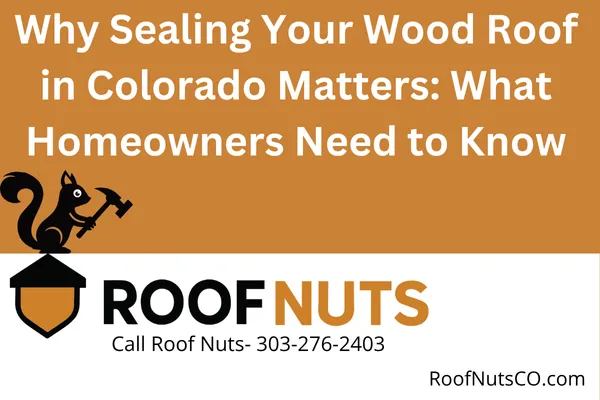
Why Sealing Your Wood Roof in Colorado Matters: What Homeowners Need to Know
Wood Roof Sealing: Why It Matters in Colorado
Wood roofing has timeless charm, but if you're in Colorado, it's not just about looks—it's about protection. Unsealed wood roofs are exposed to intense UV, rain, snow, and wind. Sealing your wood roof helps preserve its appearance, structure, and performance in this demanding climate.
Here’s what Colorado homeowners need to know.
What Does Sealing a Wood Roof Do?
Sealing is the process of applying a protective coating to your wood shakes or shingles. The sealant acts as a barrier against:
UV rays that dry out and gray wood
Moisture, which causes expansion, warping, and rot
Mildew and moss, which shorten roof life and lead to leaks
Freezing and thawing cycles, which crack unprotected wood
In short, sealing prevents damage before it starts.
Is Sealing Required in Colorado?
It’s not required by code, but it’s strongly recommended by the Cedar Shake & Shingle Bureau (CSSB) and leading inspectors like Haag Engineering in high-altitude climates like Denver, Colorado Springs, or Fort Collins. These areas have thinner air and stronger sun exposure, which dries out and deteriorates wood faster.
A sealed roof lasts longer and requires fewer costly repairs.
When Should You Seal a Wood Roof?
For new roofs: Within the first 6–12 months after installation, once the wood has acclimated.
For existing roofs: Every 3–5 years, depending on product used, sun exposure, and local conditions.
How Is a Wood Roof Sealed?
Here’s what a proper sealing job involves:
Inspection: Identify cracked, warped, or loose shingles.
Cleaning: Remove mildew, moss, and dirt with a gentle wash (no high-pressure washing).
Drying: Let the roof fully dry before application.
Application: Use a breathable, UV-resistant wood preservative—never paint or film-forming products.
Touch-ups: Focus on roof edges, ridges, and shaded areas that trap moisture.
What Sealant Should You Use?
Look for a sealant that is:
Penetrating, not film-forming
UV-resistant
Water-repellent
Mildew- and algae-resistant
Avoid clear oils that offer little UV protection. Ask your roofer for a product that’s approved by the CSSB and suited for Colorado’s climate.
Pros and Cons of Sealing
Pros:
Extends roof life by 5–15 years
Protects color and grain
Helps prevent mold, leaks, and warping
Cons:
Must be reapplied every few years
Improper application can trap moisture
Adds to long-term maintenance costs
FAQ
Does sealing make my wood roof waterproof?
No. It makes it water-resistant. Proper slope, ventilation, and underlayment are still critical.
Can I seal it myself?
It’s possible, but not recommended. Hiring a licensed roofer helps ensure the job is done safely and correctly.
How much does wood roof sealing cost in Colorado?
Costs range from $1.50 to $3.50 per square foot depending on roof size, access, and condition.
Bottom Line
If you want your wood roof to last in Colorado, sealing is not optional—it’s essential. Whether you're in Arvada, Pueblo, or Greeley, a well-sealed roof resists sun damage, water penetration, and decay, saving you thousands over time.
Have questions about sealing your wood roof?
Call Roof Nuts at 303-276-2403 or visit RoofNutsCO.com. We’re local, trusted, and ready to help.
